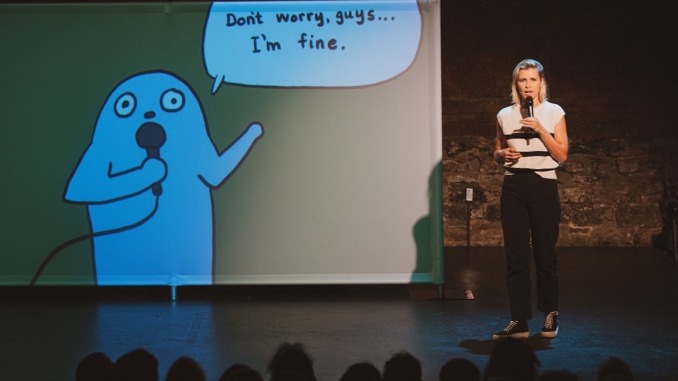Why Female Comics Are Turning to the Theater with One-Woman Shows
Photo by Arin Sang-urai
Entering the Connelly Theater for Kate Berlant’s one-woman show KATE, it’s clear you’re not in for an ordinary night of comedy. The outfit Berlant wears on stage is displayed on a mannequin next to a well-worn notebook protected by glass, and the comedian herself sits in the lobby wearing a sign that reads: “IGNORE ME.” Once inside, the multimedia show uses film projection, sound, and characters of Berlant’s creation to tell the self-aggrandizing story of a woman destined to be an actress, but held back by one fatal flaw.
KATE’s self-conscious personal myth-making is a prime example of how female comics have been innovating the stand-up form with one-woman shows. Like her podcast co-host Jacqueline Novak, who staged her own critically-acclaimed performance Get On Your Knees at the Cherry Lane Theatre in 2019 and has been touring the show in the UK and Brooklyn this summer, Berlant is just one of many female comedians bringing comedy out of the club and into the theater—and finding their greatest creative success there.
What’s so appealing about the theater for comics? For one thing, the technical capabilities of theater give them an opportunity to think outside the box of stand-up. Mo Welch, a comedian and cartoonist whose show Mole also ran at Cherry Lane this summer, saw a one-woman show as an opportunity to marry art and comedy, incorporating comics and animation into her material in a way that would be difficult to recreate in a club.
Theater also seemed like a better fit for the show because a theater audience is ready for material that might not play as well in a club.
“I have come up as a stand-up comedian, so I know how to tame the audience,” Welch says. “But I always had to do it at the very beginning of my set, because people can get super drunk at comedy clubs and what I was presenting to them was super vulnerable. Most people aren’t at a comedy club for that. They’re just there for the jokes and, you know, the cheese fries.”
When Alison Leiby performed some of the material that would become Oh God, A Show About Abortion in clubs outside of New York City, she found herself adjusting the material to hold onto crowds that were less comfortable laughing about a woman’s right to choose.
“People walk into a comedy show and either do or don’t know who the comics are, and they’re kind of there for just laughing,” says Leiby. “[My show] was titled very intentionally because I didn’t want anybody to get tricked into seeing a show about abortion, if that’s not something that they want to hear about.”
Leiby’s show was playing at Cherry Lane when the Supreme Court’s decision on abortion rights was announced, which added extra weight to the set. Performing the show in a theater made room for the moments where jokes written before the decision suddenly took on a new anger and sadness.